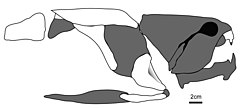

Kiangyousteus is an extinct monotypic genus of dunkleosteid from the Middle Devonian: Givetian aged Guanwu Formation in the Sichuan province of south-western China. The type species, Kiangyousteus yohii, was the first known arthrodire from Asia.[1]
Etymology
Kiangyousteus is named after Jiangyou (formerly ‘Kiangyou’) district of Sichuan Province, the location where the fossils were found in 1953 by Professor S. H. Yoh of Peking University.[1]
Phylogeny
Kiangyousteus belongs to the family Dunkleosteidae. The phylogeny of Kiangyousteus can be shown in the cladogram below:[1]
Alternatively, the subsequent 2016 Zhu et al. study using a larger morphological dataset recovered Panxiosteidae well outside of Dunkleosteoidea, leaving the status of Dunkleosteidae as a clade grouping separate from Dunkleosteoidea in doubt, as shown in the cladogram below:[2]
References
- ^ a b c You-An Zhu; Min Zhu (2013). "A redescription of Kiangyousteus yohii (Arthrodira: Eubrachythoraci) from the Middle Devonian of China, with remarks on the systematics of the Eubrachythoraci". Zoological Journal of the Linnean Society. 169 (4): 798–819. doi:10.1111/zoj12089.
- ^ Zhu, You-An; Zhu, Min; Wang, Jun-Qing (1 April 2016). "Redescription of Yinostius major (Arthrodira: Heterostiidae) from the Lower Devonian of China, and the interrelationships of Brachythoraci". Zoological Journal of the Linnean Society. 176 (4): 806–834. doi:10.1111/zoj.12356. ISSN 0024-4082.






















You must be logged in to post a comment.